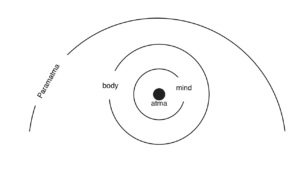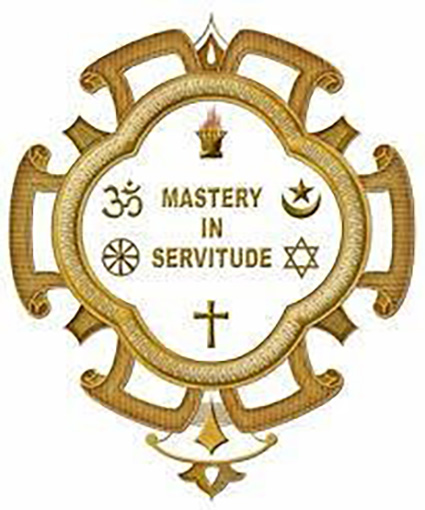
Illustration Baba drew concerning the soul (“atma”)
The individual human has, while living, a soul, a mind, and a body. Upon death the body drops away and the persistent unit is the soul and the mind, which Baba often refers to as the ego-mind. It resides in two other bodies that do not drop away at death, called the subtle body and the mental body. The illustration encapsulates the ego-mind, the mental body and the subtle body in the label on the drawing, “mind.” All this exists, though its separation is illusory, within Paramatma or the Oversoul. Baba’s lecture, which accompanies the illustration, addresses how the soul progresses from body to body. Baba refers to the separate soul as a drop in the Ocean of eternity:
Before listening to the explanation of the chart, fix your attention to this one point for a moment. Because of these covers [of the mind and body], the drop does not see the Ocean.
Now what happens? The body drops, but the mind remains. And when the body drops, its impressions [otherwise termed “sanskaras”] immediately manifest, trying to spread themselves and assume a new body. They want expression through the body, and so another body comes into existence which is made up of these impressions.
Thus, with the dropping of every form, the sanskaras want to take another body. If these sanskaras are crooked — meaning, evil — the body is also crooked — diseased, for example. If the sanskaras are bad, the body suffers pain; if they are good, the mind is happy.
So long as the mind is there, the impressions also will be there and, with these, the body also. The soul won’t see God until the sanskaras are finished. Dropping of the body is therefore of no avail, but if the mind goes, then there are no sanskaras left. They disappear. But the paradox is that the body’s falling and sanskaras asking for another body (to spend themselves) help the soul gradually to gain self consciousness for the drop to see the Ocean — the Oversoul. Sourced from Lord Meher online edition, page 2345 “Wartime Travel for Masts”.
